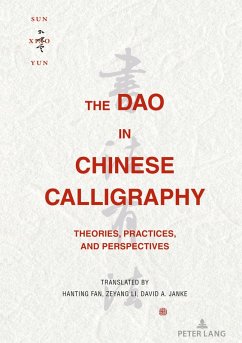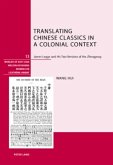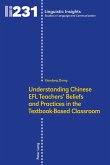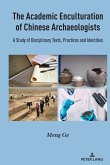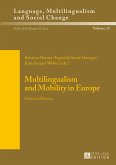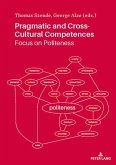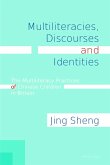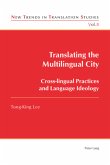- Gebundenes Buch
- Merkliste
- Auf die Merkliste
- Bewerten Bewerten
- Teilen
- Produkt teilen
- Produkterinnerung
- Produkterinnerung
This book explores the profound connection between traditional Chinese calligraphy and its philosophical roots. In a world where innovation often overshadows tradition, this book serves as a crucial reminder of the value and significance of ancient practices that have shaped the art form for centuries. The author embarks on an investigative journey to rediscover the ancient techniques employed by the revered calligrapher Wang Xizhi, which have been lost for nearly 700 years. Through rigorous experimentation, she reveals that true calligraphy must adhere to these traditional methods; otherwise,…mehr
Andere Kunden interessierten sich auch für
![Translating Chinese Classics in a Colonial Context Translating Chinese Classics in a Colonial Context]() Wang HuiTranslating Chinese Classics in a Colonial Context92,95 €
Wang HuiTranslating Chinese Classics in a Colonial Context92,95 €![Understanding Chinese EFL Teachers' Beliefs and Practices in the Textbook-Based Classroom Understanding Chinese EFL Teachers' Beliefs and Practices in the Textbook-Based Classroom]() Xiaodong ZhangUnderstanding Chinese EFL Teachers' Beliefs and Practices in the Textbook-Based Classroom66,40 €
Xiaodong ZhangUnderstanding Chinese EFL Teachers' Beliefs and Practices in the Textbook-Based Classroom66,40 €![The Academic Enculturation of Chinese Archaeologists The Academic Enculturation of Chinese Archaeologists]() Meng GeThe Academic Enculturation of Chinese Archaeologists91,55 €
Meng GeThe Academic Enculturation of Chinese Archaeologists91,55 €![Multilingualism and Mobility in Europe Multilingualism and Mobility in Europe]() Multilingualism and Mobility in Europe80,20 €
Multilingualism and Mobility in Europe80,20 €![Pragmatic and Cross-Cultural Competences Pragmatic and Cross-Cultural Competences]() Pragmatic and Cross-Cultural Competences42,80 €
Pragmatic and Cross-Cultural Competences42,80 €![Multiliteracies, Discourses and Identities Multiliteracies, Discourses and Identities]() Jing ShengMultiliteracies, Discourses and Identities70,50 €
Jing ShengMultiliteracies, Discourses and Identities70,50 €![Translating the Multilingual City Translating the Multilingual City]() Tong King LeeTranslating the Multilingual City77,40 €
Tong King LeeTranslating the Multilingual City77,40 €-
-
-
This book explores the profound connection between traditional Chinese calligraphy and its philosophical roots. In a world where innovation often overshadows tradition, this book serves as a crucial reminder of the value and significance of ancient practices that have shaped the art form for centuries. The author embarks on an investigative journey to rediscover the ancient techniques employed by the revered calligrapher Wang Xizhi, which have been lost for nearly 700 years. Through rigorous experimentation, she reveals that true calligraphy must adhere to these traditional methods; otherwise, it becomes mere painting. She emphasized that any departure from Wang Xizhi's methods undermines the essence of calligraphy itself.
By reframing the discourse around calligraphy, the author invites readers to appreciate the depth of the traditional approach.
By reframing the discourse around calligraphy, the author invites readers to appreciate the depth of the traditional approach.
Produktdetails
- Produktdetails
- Verlag: Peter Lang
- Artikelnr. des Verlages: X675036
- 1. Auflage
- Seitenzahl: 328
- Erscheinungstermin: 24. März 2025
- Englisch
- Abmessung: 216mm x 153mm x 21mm
- Gewicht: 493g
- ISBN-13: 9783034350365
- ISBN-10: 3034350368
- Artikelnr.: 73710631
- Herstellerkennzeichnung
- Libri GmbH
- Europaallee 1
- 36244 Bad Hersfeld
- gpsr@libri.de
- Verlag: Peter Lang
- Artikelnr. des Verlages: X675036
- 1. Auflage
- Seitenzahl: 328
- Erscheinungstermin: 24. März 2025
- Englisch
- Abmessung: 216mm x 153mm x 21mm
- Gewicht: 493g
- ISBN-13: 9783034350365
- ISBN-10: 3034350368
- Artikelnr.: 73710631
- Herstellerkennzeichnung
- Libri GmbH
- Europaallee 1
- 36244 Bad Hersfeld
- gpsr@libri.de
Sun Xiaoyun, a distinguished calligrapher, started her classical training at the tender age of three. She serves as President of the China Calligraphers Association and Honorary Director of the Jiangsu Art Museum.
Preface to Peter Lang Edition - Preface to Original Edition - Calligraphy: Truly Deserving of 'China' - Three Incidents That Perplexed Me - 'Getting to the Root' - What Does 'Convenience' Mean? - The Blind Men and an Elephant - Doubting the 'Eight Principles of the Character Yong' - Mastering Brush Grip - 'Five Fingers' or 'Five Characters' - Visualizing 'Adjusting the Stirrups' - Calligraphy: Mastering Brushwork Techniques - Man is the Measure of All Things' - The Emergence of Brushwork Techniques 1. 'Gathering the Brush-tip ' and Continuous Writing - The Emergence of Brushwork Techniques 2. Writing Without Support - Reasoning Boldly - Diameter of the Brush Shaft - Brush Bristle: Length and Hardness - The Origin of Paper and the Concept of 'Move, Lift, Hold, and Dye' - Insights from 'The Execution of Chen Shimei' - Brushwork Techniques Root in Writing Posture - The Swan Song of 'the Ancient Method' - Unconscious Loss - Merits and Demerits of Using a Table - Exploring the 'Eight-Point Script' - Shaping Form and Momentum through Xiang and Bei - What a Giant Elephant! - The Culmination of Calligraphy: Zhangcao - The Physiological Limits of Lihua and Meihua - Wanfa: Weaving Three Strands into One - Shangfa: Engraving the Calligraphy of Wang Xizhi in the Heart - Bianfa: Perseverance of Brushwork Techniques amid Evolution of Characters - Wufa: Accepting the Unavoidable Reality - Is Calligraphy a Visual Art? - Decoding Ancient Analogies - The Regeneration of Rotational Momentum in Brushwork - Understanding 'Contraction' and 'Expansion' - Semi-cursive Script: the Last to Take the Stage - Personalizing Aesthetics in the Art of Calligraphy - Deciphering the Misconstrued 'Intention Comes Before Writing - The Impact of Brush Rotating on Right-to-Left Vertical Writing - Debunking the Myth of 'Solid Fingers and Open Palms' - Describing the Unseen Sun to the Blind - The Inadvertent Mislabeling: A Reflection on 'Calling a Stag a Horse' - Unraveling the Study of Tie: An Examination of Its Collapse - Reassessing the Study of Bei - The Pitfalls of 'Drawing Characters' - A Concise Historic Overview of Japanese Calligraphy - Distinguishing the Boundaries Between Calligraphy and Painting - The Frustrating Debate on 'the Essence of Calligraphy' - Decoding the Universal Principles of Calligraphy - A Revelatory Moment During Commute - The Confusion about Traditional Chinese Painting - Unveiling the Association Between gufa and Brushwork Techniques - Exploring the Shared Origins of Calligraphy and Traditional Chinese Painting - The Indispensable Role of Brushwork Techniques in the Traditional Chinese Painting - The Singular Trajectory to Mount Hua's Summit - Literati Painting - The Distant Mountain in the Mist - 'When a Painting Resembles its Subject, it is Reminiscent of a Child's Work' - The Imitation Game - Truth and Helplessness - The Tale of Jizi - Postscript to the Revised Edition - Works by Sun Xiaoyun - Bibliography - Translators' Acknowledgment - Index.
Preface to Peter Lang Edition - Preface to Original Edition - Calligraphy: Truly Deserving of 'China' - Three Incidents That Perplexed Me - 'Getting to the Root' - What Does 'Convenience' Mean? - The Blind Men and an Elephant - Doubting the 'Eight Principles of the Character Yong' - Mastering Brush Grip - 'Five Fingers' or 'Five Characters' - Visualizing 'Adjusting the Stirrups' - Calligraphy: Mastering Brushwork Techniques - Man is the Measure of All Things' - The Emergence of Brushwork Techniques 1. 'Gathering the Brush-tip ' and Continuous Writing - The Emergence of Brushwork Techniques 2. Writing Without Support - Reasoning Boldly - Diameter of the Brush Shaft - Brush Bristle: Length and Hardness - The Origin of Paper and the Concept of 'Move, Lift, Hold, and Dye' - Insights from 'The Execution of Chen Shimei' - Brushwork Techniques Root in Writing Posture - The Swan Song of 'the Ancient Method' - Unconscious Loss - Merits and Demerits of Using a Table - Exploring the 'Eight-Point Script' - Shaping Form and Momentum through Xiang and Bei - What a Giant Elephant! - The Culmination of Calligraphy: Zhangcao - The Physiological Limits of Lihua and Meihua - Wanfa: Weaving Three Strands into One - Shangfa: Engraving the Calligraphy of Wang Xizhi in the Heart - Bianfa: Perseverance of Brushwork Techniques amid Evolution of Characters - Wufa: Accepting the Unavoidable Reality - Is Calligraphy a Visual Art? - Decoding Ancient Analogies - The Regeneration of Rotational Momentum in Brushwork - Understanding 'Contraction' and 'Expansion' - Semi-cursive Script: the Last to Take the Stage - Personalizing Aesthetics in the Art of Calligraphy - Deciphering the Misconstrued 'Intention Comes Before Writing - The Impact of Brush Rotating on Right-to-Left Vertical Writing - Debunking the Myth of 'Solid Fingers and Open Palms' - Describing the Unseen Sun to the Blind - The Inadvertent Mislabeling: A Reflection on 'Calling a Stag a Horse' - Unraveling the Study of Tie: An Examination of Its Collapse - Reassessing the Study of Bei - The Pitfalls of 'Drawing Characters' - A Concise Historic Overview of Japanese Calligraphy - Distinguishing the Boundaries Between Calligraphy and Painting - The Frustrating Debate on 'the Essence of Calligraphy' - Decoding the Universal Principles of Calligraphy - A Revelatory Moment During Commute - The Confusion about Traditional Chinese Painting - Unveiling the Association Between gufa and Brushwork Techniques - Exploring the Shared Origins of Calligraphy and Traditional Chinese Painting - The Indispensable Role of Brushwork Techniques in the Traditional Chinese Painting - The Singular Trajectory to Mount Hua's Summit - Literati Painting - The Distant Mountain in the Mist - 'When a Painting Resembles its Subject, it is Reminiscent of a Child's Work' - The Imitation Game - Truth and Helplessness - The Tale of Jizi - Postscript to the Revised Edition - Works by Sun Xiaoyun - Bibliography - Translators' Acknowledgment - Index.

